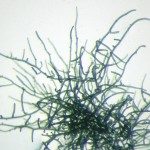2017 Aug, chapter 3, pages 43-78. Wiley.
This chapter summarizes the most commonly used methods for the isolation, purification,
and cultivation of toxic cyanobacteria. The aim is to give general advice on how to isolate
and maintain clonal cyanobacterial cultures in order to use them in genetic studies.
The traditional methods for the isolation of cyanobacteria into culture are well established
and described and there are several excellent reviews with detailed information on culturing
techniques

